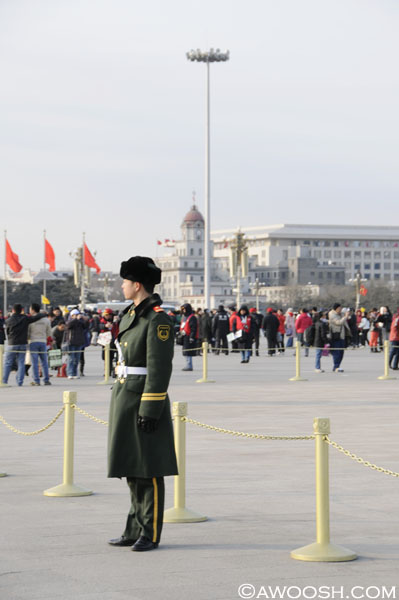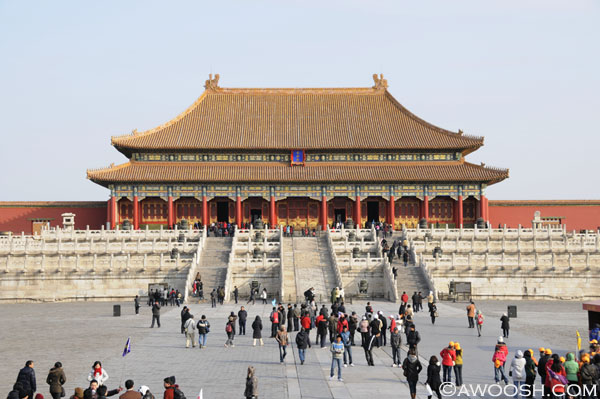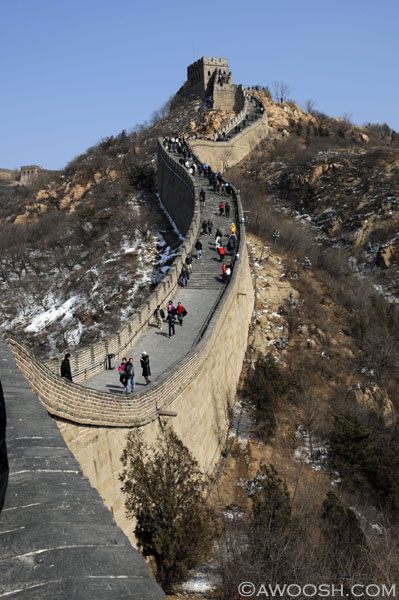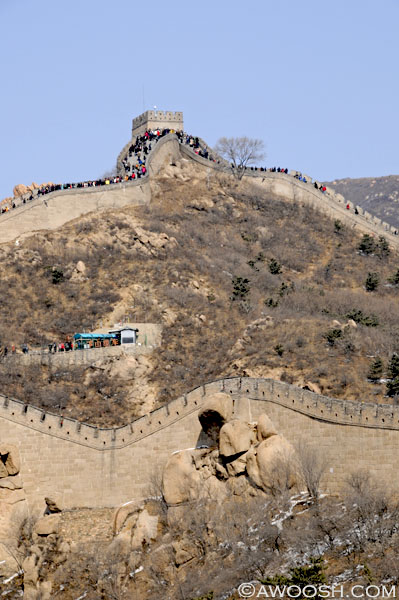Awoosh Reports:
Tripping in Asia 2010
Part One - Beijing
Our diving trip to Asia started in Beijing. Two weeks before our planned departure our travel agent called to say we had been rerouted (we were traveling on Aeroplan points), and that instead of Tokyo, we would be transiting through Beijing. She highly recommended that we stay and tour Beijing for at least one day, and we took her advice. She set up a private cultural guide and driver (at a very reasonable cost) who met us at the airport, escorted us to our hotel, picked us up early the next morning for a full day tour, and then picked us up early the next morning and got us back to the airport. It was the perfect way to get a taste of China, without the hassles of trying to use transit or cabs.
I don't really know what I expected of Beijing - but what we found was a massive (population now 20 million!!!) ultra modern city, with pockets of historical areas. There are 4 million vehicles in Beijing, and the traffic jams are epic on the main thoroughfares and ring roads. We got pretty lucky with the weather - it was clear and cold, and we had blue skies in the morning in Beijing, which is rare with all the smog.
Our first stop on our day tour was Tiananmen Square.
 |
So here's the thing: The Chinese government imposes strict controls on media in China. Even our guide, who is a university graduate (in China) in Chinese History does not know what really happened in Tiananmen Square in 1989. The information is simply not available, and there is no mention of the events in school, media, history books etc. The internet is also controlled, and a googlewhack or similar comes up blank. The party line is that a bunch of students staged a violent uprising and killed many armed forces.
There was a strong police/military presence in the square when we were there - our guide recommended that I be quite surreptitious taking pix of them, as it is "not allowed".
 |
From Tiananmen Square you can see the main entrance to the Forbidden City. Check out the Mao pic hanging on the building. He is clearly beloved and his likeness is evident all over Beijing.
 |
The Forbidden City is impressive. It is a massive site (now deemed World Heritage), comprised of a series of huge courtyards that lead into the next - each representing a layer of privilege and inner circle of the ruling Emporer of the time. In the inner sanctum was the digs of the ruling Emporer, his wife (selected by his mother), his concubines (selected by him ;^), and his children.
The buildings are all made of wood and are beautifully preserved. It all gets to be a bit boggling after a while - the huge site makes the Louvre look pretty puny by comparison...
 |
This is the Hall of Supreme Harmony - I think it is the largest structure on the site. You can't go in any of the buildings, but you can peak through doorways into the darkened structures. Many of the antiquities were removed by Chiang Kai Shek during the civil war and continue to reside in the National Museum in Taipei.
After touring the Forbidden City, we moved on to a bicycle rickshaw tour of a Hutong, which is a word which is used to describe the labrythine neighbourhoods of Beijing. These little winding streets run off the main boulevards and avenues. We were invited into the home of a man who owned a 200+ year old house in one of the hutongs. He does not own the land - not permitted - and at one point, during the Cultural Revolution, ownership of his home was taken away by the government, and tenants imposed on him at a nominal rent. When the government reversed their decision many years later, he was forced to pay a "management fee" to the government to get the title of his house back. He smiled when he told us this story, but I suspect it was a very sore point with him, especially to have strangers living in his home for many years - one of which refused to leave for several years after the reversal. He was very open, and with our guide translating we were able to have a very interesting and informative chat with him about home/land ownership, living through the Cultural Revolution, and life in Beijing.
Our guide herself is first generation of the "one child" policy - she too was open to conversation about the concept, and from her we learned some interesting tidbits - one being that a woman who became pregnant when she already had her one child would be pressured by neighbourhood groups to abort her second baby. If she did not, she and her husband would lose their jobs - and since everyone is pretty much an employee of the state, they would not be able to regain employment anywhere else. The exception to the one child law is for farmers - if they have a daughter first time out, they may try again, once more, for a son. We did not get into infanticide of female babies that we read about in the free world press, but given the cultural preference for boys, it must happen with alarming frequency...
After the hutong visit, we hopped back in the car and headed for lunch - a Chinese banquet style meal with seemingly neverending plates of yumminess arriving at the table with steaming regularity.
After lunch, back in the car. The driver headed northwest, to a section of the Great Wall that is about 50 kms from Beijing. The city of Beijing sprawls, with a density that makes NYC look pretty tame in comparison.
The Great Wall is all that - a massive structure that boggles the mind in terms of dimension and the labour required to build it. Depending on which source you choose to believe, it is over 5000 miles long and took over 5000 years to construct. It was constructed to protect northern China from marauding Mongolians (Genghis Khan and his ilk) who were constantly raiding China.
 |
This section of the wall (Badaling) is very touristed. The stairs are steep and slippery, but the views are worth the peril. Yes, we climbed to the top of this section :^)
 |
There are more pictures from Beijing in gallery a on Awoosh - I have tried to offer explanations of what we saw and learned - they are below the large images, so you need to click on the the thumbs to read them. The gallery is here -----> http://www.awoosh.com/gallery/Beijing-2010
Next stop - Critter diving at Lembeh!
Trip Slideshow
Trip Galleries
Part One - Beijing, China
Part Two - Lembeh, Indonesia
Part Three - Ambon, Indonesia
Part Four - Raja Ampat, Indonesia